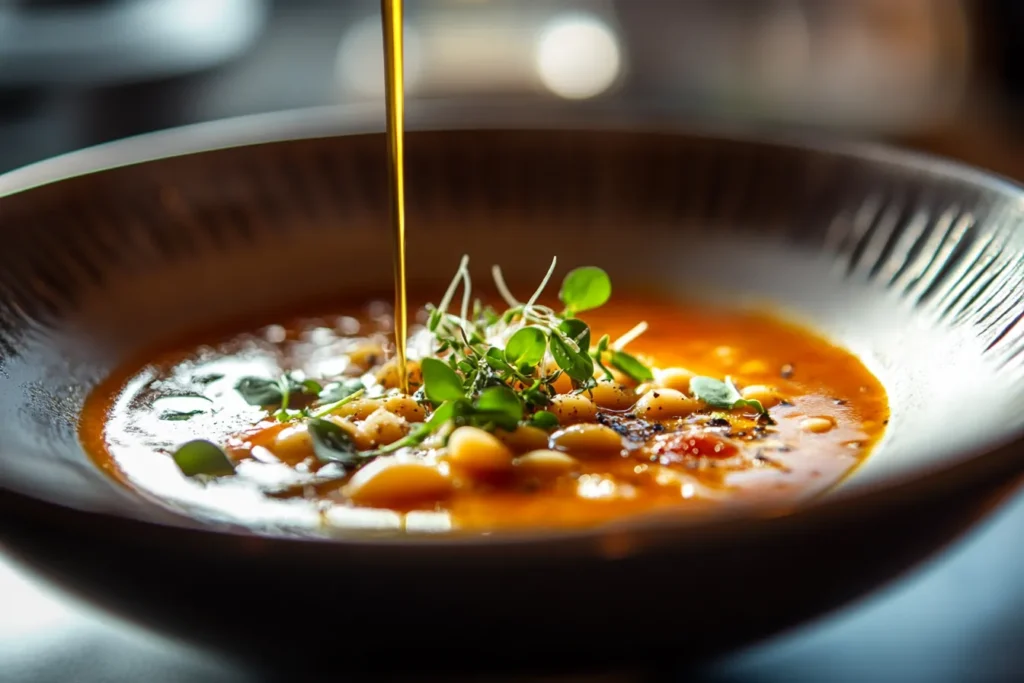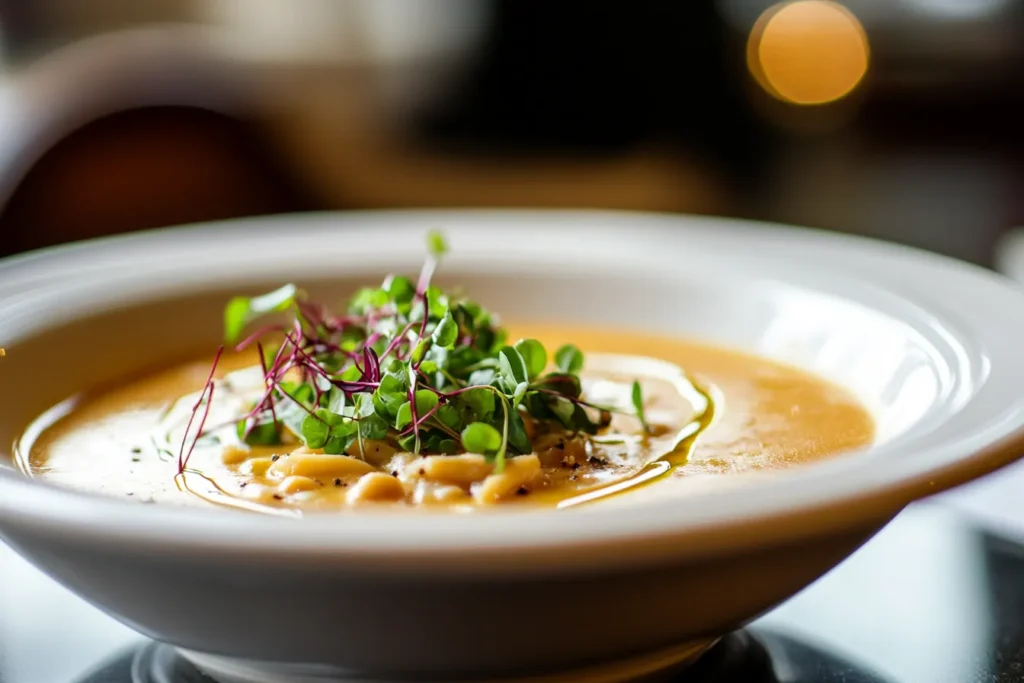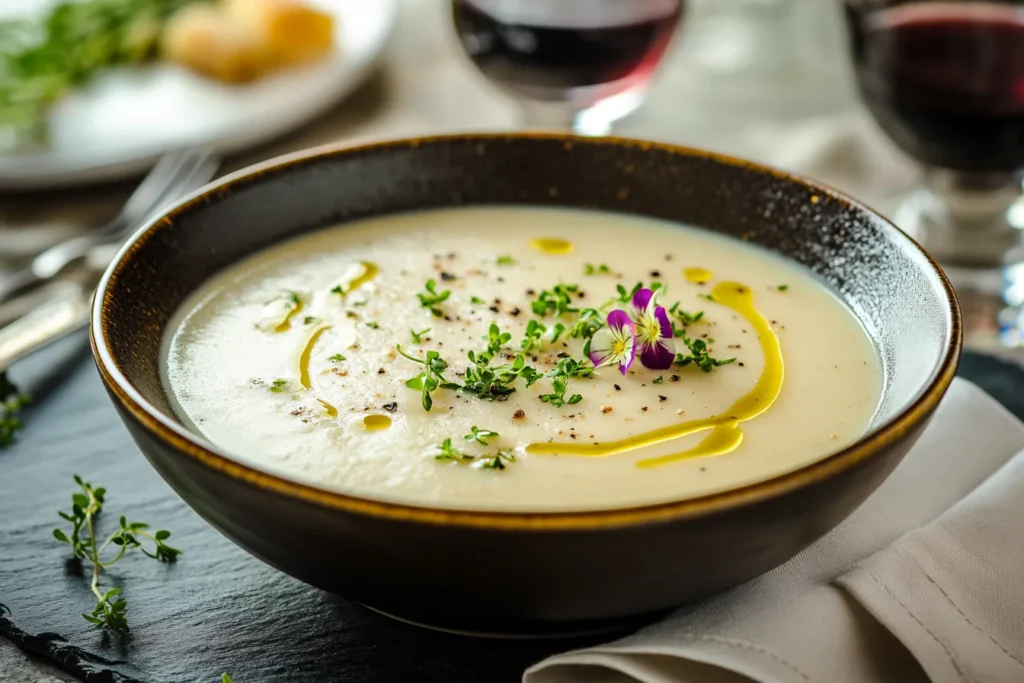Have you ever craved a meal that’s not only comforting but also incredibly easy to make and deeply satisfying? If so, Pasta e Fagioli might be exactly what you’ve been searching for. To begin with, picture a steaming bowl of tender pasta, hearty beans, and a rich, flavorful tomato broth, all coming together in a dish that feels like a cozy hug on a cold day. Furthermore, whether you’re short on time, trying to stretch your pantry staples, or simply looking for a wholesome dinner to share with loved ones, this classic Italian recipe checks all the boxes. In addition, its timeless appeal lies in its simplicity and versatility, making it a go-to dish for all occasions. Ultimately, let’s dive into why Pasta e Fagioli remains a cherished favorite and, more importantly, how you can customize it to suit your tastes!
List Of Contents
1. What is Pasta Fagioli? A Historical Overview
Pasta Fagioli, pronounced pah-stah fah-joh-lee, is an Italian classic that translates to “pasta and beans.” This dish has humble origins, rooted in Italian peasant cooking or “cucina povera”, emphasizing affordable and accessible ingredients. The dish was originally crafted by resourceful Italian families who transformed simple staples—beans, pasta, and a few herbs—into a heartwarming meal.
Throughout Italy, the dish gained prominence as a symbol of comfort food, embodying simplicity and nourishment. In rural areas, families relied heavily on beans as a protein source, creating dishes that were both economical and nutritious. As Italian cuisine evolved, Pasta Fagioli remained a beloved staple, celebrated for its ability to bring people together over a steaming bowl of goodness. Check out more recipes here.

2. The Origins of the Name “Pasta Fagioli”
The term “Fagioli” directly translates to “beans” in Italian. The name reflects the dish’s main ingredient: legumes. While there’s no definitive record of its invention, Pasta Fagioli’s existence is deeply tied to Italy’s agricultural traditions.
Each region of Italy has its own twist on the name and recipe, influenced by local dialects and ingredient availability. This linguistic diversity provides a glimpse into the country’s rich culinary heritage. For instance, in Northern Italy, you might find a creamier version of the dish, while Southern Italy favors a lighter, tomato-based approach. Check out more recipes here.
3. What is Pasta Fazool? A Colloquial Twist
In Italian-American communities, Pasta Fagioli became affectionately known as Pasta Fazool. This adaptation stems from the Southern Italian dialect, particularly Neapolitan, where “fagioli” is pronounced “fazool” or “fa-zool.”
The phrase gained widespread recognition in the United States, popularized by iconic cultural references such as Dean Martin’s song “That’s Amore,” where he sings, “When the stars make you drool, just like Pasta Fazool…”
This colloquial twist highlights how Italian immigrants preserved their traditions while adapting to a new cultural landscape. Check out more recipes here.
4. Italian-American Influence on Pasta Fazool
The rise of Pasta Fazool in America coincided with waves of Italian immigration during the late 19th and early 20th centuries. Immigrants from Southern Italy brought their culinary traditions to cities like New York and Chicago, where they adapted recipes to fit their new environment.
In America, Pasta Fazool often features heartier ingredients like sausage or ground beef, reflecting the influence of abundance in the New World. The dish also shifted from a peasant meal to a celebrated centerpiece at Italian-American gatherings. Check out more recipes here.
5. Comparing Regional Dialects: Southern Italy and American Adaptations
Southern Italy’s dialects have a profound influence on the way Pasta Fagioli is perceived and prepared. The Neapolitan pronunciation “fazool” showcases how regional language shapes culinary traditions. While Pasta Fagioli in Italy tends to be simple and rustic, its American counterpart often leans toward bolder flavors and richer textures. Check out more recipes here.
Key Differences Between Southern Italy and American Variations:
- Italy: Minimalist ingredients with a focus on fresh, local produce.
- America: Additions like bacon, meat, or extra seasonings for a robust flavor profile.
6. Evolution of Pasta Dishes: From Traditional to Modern Interpretations
The journey of Pasta Fagioli from its humble beginnings to its modern-day interpretations is a testament to its versatility. Traditional recipes were shaped by necessity, emphasizing frugality and ingenuity. Modern versions, however, showcase creativity, featuring gourmet twists such as truffle oil, pancetta, or gluten-free pasta.
The dish has even inspired fusion recipes, combining elements of other cuisines while retaining its Italian essence.
7. Key Ingredients in Pasta Fagioli
A traditional Pasta Fagioli recipe relies on:
- Beans (often cannellini or borlotti)
- Pasta (ditalini or other small shapes)
- Tomatoes (fresh or canned)
- Garlic and Onions for aromatic depth
- Herbs like rosemary, thyme, or parsley
- Olive Oil as the foundational fat
These ingredients come together to create a dish that’s both nutritious and flavorful, showcasing the power of simple, quality components.
8. Common Variations Found in Pasta Fazool
Italian-American interpretations, or Pasta Fazool, often include:
- Protein Additions: Sausage, ground beef, or pancetta.
- Spicy Elements: A touch of red pepper flakes for heat.
- Cheese Toppings: Generous shavings of Parmesan or Pecorino Romano.
These variations highlight the creative adaptations made by immigrant communities while staying true to the spirit of the dish.
9. Cultural Significance: Why These Dishes Matter to Italians and Italian-Americans
Pasta Fagioli and Pasta Fazool are more than just meals—they are culinary narratives. For Italians, Pasta Fagioli represents a connection to the land, tradition, and family. For Italian-Americans, Pasta Fazool is a nostalgic bridge to their heritage, often served at family gatherings or holidays.
This cultural duality underscores the enduring significance of food as a marker of identity.
10. Culinary Terminology: Understanding “Fagioli” vs. “Fazool”
While “Fagioli” is the proper Italian term for beans, “Fazool” reflects the dialectical charm of Southern Italy. Both terms carry a sense of authenticity, though they cater to different linguistic and cultural audiences.
Key Differences Between Pasta Fagioli and Pasta Fazool

1. Pronunciation: How Language Shapes Perception
The pronunciation of Pasta Fagioli versus Pasta Fazool showcases the intersection of language and culture. In standard Italian, the word “fagioli” is pronounced fah-joh-lee. However, in the Southern Italian dialect, the “gli” sound often softens to a “l” or “luh” sound, transforming it into “fazool.”
When Italian immigrants arrived in the U.S., they brought their regional dialects, which influenced how traditional dishes were named and pronounced. Over time, Pasta Fazool became a familiar phrase in Italian-American households, emphasizing the cultural adaptation of linguistic heritage.
Linguistic Highlights:
- Standard Italian: Pronounced with formality, rooted in tradition.
- Dialectical Italian: Informal and expressive, reflective of everyday speech.
2. Ingredient Adaptations: Traditional Fagioli vs. Fazool Recipes
Traditional Pasta Fagioli relies heavily on the simplicity of its ingredients:
- Fresh beans harvested seasonally.
- Homemade pasta shaped by hand.
- A basic seasoning palette to let the ingredients shine.
On the other hand, Pasta Fazool often incorporates richer, more accessible elements:
- Canned beans for convenience.
- Store-bought pasta varieties like macaroni.
- Heavier seasoning with garlic powder or paprika.
These adaptations reflect the blending of Italian culinary roots with American pragmatism.
3. Broth Consistency: Thick and Hearty vs. Soupy and Light
One of the defining differences between Pasta Fagioli and Pasta Fazool lies in the consistency of the broth:
- Traditional Italian Style: Often thicker, achieved by mashing some of the beans to create a creamy texture without added dairy.
- Italian-American Style: Tends to be more soupy, with a tomato-forward base for a robust flavor.
The choice of broth consistency often depends on regional preferences and the occasion for which the dish is prepared. In colder climates, the thicker style might feel more comforting, while the lighter version suits warmer seasons.
4. Pasta Types Used in Each Variation
The type of pasta chosen for these dishes plays a crucial role in defining their texture and character:
- Traditional Pasta Fagioli: Small pasta shapes like ditalini or orzo, which blend seamlessly into the dish.
- Pasta Fazool: Often includes elbow macaroni or shells, making the dish heartier and more recognizable to American palates.
Both versions share a commitment to using pasta that complements the beans and broth without overpowering them.
5. Use of Herbs and Spices: Authentic Italian vs. Italian-American Preferences
Herbs and spices in Pasta Fagioli are minimal but impactful, showcasing the Italian philosophy of “less is more.” Common additions include:
- Fresh rosemary
- Thyme
- Parsley
Conversely, Pasta Fazool often leans into dried herbs like oregano or basil, reflecting the influence of pantry staples in American kitchens. Some recipes may even include a sprinkle of chili flakes or garlic powder for added zest.
Key Flavor Profiles:
- Pasta Fagioli: Clean, herbal, and subtle.
- Pasta Fazool: Bolder, with a fusion of Italian and American tastes.
6. Cooking Techniques: Traditional Italian Methods vs. American Shortcuts
Traditional Pasta Fagioli requires patience and care:
- Beans are soaked overnight and simmered slowly.
- Broth is built gradually, layering flavors over time.
Italian-American Pasta Fazool, however, adapts to busy lifestyles:
- Canned beans cut down on prep time.
- Broth is enhanced quickly with tomato paste or bouillon cubes.
These shortcuts make Pasta Fazool more accessible for weeknight cooking without sacrificing its essence.
7. Influence of Availability on Ingredients in Italian-American Fazool
When Italian immigrants arrived in the U.S., they had to adapt their recipes to what was available. Ingredients like olive oil and fresh herbs were sometimes hard to find, leading to substitutions such as:
- Vegetable oil instead of olive oil.
- Canned tomatoes in place of fresh.
- Cheaper cuts of meat to stretch the dish.
These substitutions highlight the ingenuity of immigrant communities in preserving their culinary traditions in a new environment.
8. Role of Meat: Vegetarian Origins vs. Modern Additions
Traditional Pasta Fagioli is often vegetarian, primarily because meat was considered a luxury in many Italian households. Furthermore, the protein content of beans served as the dish’s primary source of sustenance, making it both nourishing and economical.
In contrast, Pasta Fazool frequently incorporates meat, such as pancetta or bacon, which adds a smoky undertone. Additionally, sausage is often used for added heartiness, while ground beef offers an Americanized twist to the dish.
These additions not only enhance the flavor but also reflect the abundance and accessibility of meat in the United States, which allowed Italian-American communities to adapt and enrich the original recipe.and its integration into Italian-American diets.
9. Presentation and Serving Styles: Homestyle vs. Restaurant Variations

The way Pasta Fagioli and Pasta Fazool are served also differs:
- Traditional Homestyle: Served in a rustic, family-style manner, often with crusty bread on the side.
- Restaurant Style: Elevated with garnishes like a drizzle of olive oil, grated cheese, or fresh parsley.
The presentation reflects the audience and occasion, with homestyle preparations focusing on comfort and restaurant versions highlighting aesthetic appeal.
10. Nutritional Profile: Traditional Dishes Compared
Nutritionally, Pasta Fagioli is a powerhouse:
- High in fiber from beans and vegetables.
- Moderate in calories, especially in vegetarian versions.
- Packed with protein, making it a well-rounded meal.
Pasta Fazool often carries more calories and fat due to the inclusion of meat and cheese, but it still retains its nutritional core thanks to the beans and pasta.
Cooking and Enjoying Pasta Fagioli and Pasta Fazool
1. How to Make Traditional Pasta Fagioli at Home
Creating authentic Pasta Fagioli at home is an enriching culinary experience. This classic recipe focuses on simple ingredients prepared with care.
Ingredients:
- 1 cup dried cannellini beans (or two cans of cooked beans)
- 1/2 cup ditalini pasta
- 2 tablespoons extra-virgin olive oil
- 1 small onion, finely chopped
- 2 garlic cloves, minced
- 1 sprig of rosemary
- 2 cups vegetable broth
- 1 cup crushed tomatoes
- Salt and pepper to taste
Steps:
- Prepare the Beans: Soak dried beans overnight, then boil them until tender. If using canned beans, rinse and set aside.
- Create the Base: Sauté onion and garlic in olive oil until fragrant. Add rosemary for flavor.
- Simmer: Add the broth, beans, and tomatoes, simmering gently to blend flavors.
- Cook the Pasta: Boil pasta separately until al dente, then mix into the soup.
- Finish and Serve: Adjust seasoning, drizzle with olive oil, and serve with fresh bread.
This version honors the traditional roots of Pasta Fagioli, focusing on its hearty simplicity.
2. A Step-by-Step Guide to Crafting Pasta Fazool
For an Italian-American twist, Pasta Fazool incorporates meat and bolder flavors.
Ingredients:
- 1 cup canned cannellini beans
- 1/2 pound Italian sausage or pancetta
- 1/2 cup elbow macaroni
- 1 small onion, diced
- 2 garlic cloves, minced
- 1/2 teaspoon red pepper flakes
- 1 cup crushed tomatoes
- 2 cups chicken or beef broth
- Grated Parmesan for garnish
Steps:
- Cook the Meat: Sauté sausage or pancetta until browned, then set aside.
- Build the Base: In the same pan, cook onion, garlic, and red pepper flakes until aromatic.
- Combine Ingredients: Add the beans, tomatoes, and broth, simmering for 20 minutes.
- Prepare the Pasta: Cook the macaroni separately, then stir it into the pot.
- Finish and Serve: Add the cooked meat, adjust seasoning, and serve with a sprinkle of Parmesan.
This recipe delivers the bold flavors and heartiness that Italian-American cuisine is known for.
3. Selecting the Right Ingredients for Authentic Flavor
The key to both Pasta Fagioli and Pasta Fazool lies in ingredient quality. Here are a few tips to enhance authenticity:
- Use dried beans instead of canned for a richer taste.
- Opt for San Marzano tomatoes for a sweeter, less acidic flavor.
- Choose artisanal pasta to replicate the texture of homemade varieties.
For herbs, always prioritize fresh over dried when possible to achieve the most vibrant flavor.
4. Cooking Tips to Perfect the Broth and Pasta Texture
Balancing broth and pasta is crucial for these dishes. Here are expert tips:
- Mash Some Beans: This creates a creamy broth without added cream.
- Cook Pasta Separately: Prevents overcooking and ensures the broth remains clear.
- Simmer Slowly: Low heat allows flavors to meld beautifully.
By following these techniques, you can achieve restaurant-quality results at home.
5. Pairing Suggestions: Wines, Breads, and Side Dishes
Pairing your meal thoughtfully can elevate the dining experience:
- Wines: A Chianti pairs well with Pasta Fagioli, while a Zinfandel complements Pasta Fazool.
- Breads: Serve with a crusty sourdough or garlic focaccia.
- Sides: A crisp Caesar salad or roasted vegetables adds balance.
These pairings enhance the comforting and robust flavors of these dishes.
6. Modern Fusion Recipes Inspired by Pasta Fagioli
Contemporary chefs are reimagining Pasta Fagioli with creative twists:
- Vegan Variants: Substituting beans like chickpeas or lentils for unique textures.
- Spicy Versions: Incorporating chili oil or jalapeños for a kick.
- Global Fusion: Adding miso paste or turmeric for an international flair.
These modern interpretations honor the dish’s roots while appealing to diverse palates.
7. How to Adapt Recipes for Dietary Preferences
Customizing these dishes for dietary needs is simple:
- Gluten-Free: Use gluten-free pasta or omit it entirely in favor of extra beans.
- Vegetarian: Opt for vegetable broth and skip meat-based ingredients.
- Low-Sodium: Choose low-sodium broth and season with herbs instead of salt.
These adjustments ensure that Pasta Fagioli and Pasta Fazool remain inclusive and accessible.
8. Common Mistakes to Avoid While Preparing These Dishes
To avoid pitfalls, keep these tips in mind:
- Don’t Overcook Pasta: It will continue to absorb broth after cooking.
- Avoid Excess Salt: Beans and broth already contribute natural sodium.
- Skip Shortcuts on Broth: Homemade broth significantly enhances flavor.
By sidestepping these errors, you can create a dish that’s both authentic and delicious.
9. Celebrating Tradition: Hosting an Italian Feast with Pasta Fagioli or Fazool
Hosting an Italian-themed feast is a wonderful way to celebrate these dishes:
- Begin with antipasto platters featuring cured meats and cheeses.
- Serve Pasta Fagioli or Pasta Fazool as the centerpiece.
- Finish with a classic dessert like tiramisu or cannoli.
This approach highlights the communal spirit of Italian dining, where food is a celebration of life.
10. FAQs
- Is Pasta Fagioli always vegetarian?
- Traditionally, yes, but modern recipes may include meat.
- What type of beans should I use?
- Cannellini or borlotti beans are preferred for their creamy texture.
- Why is Pasta Fazool more popular in the U.S.?
- Its name and flavor adaptations resonate with Italian-American communities.
- Can I freeze leftovers?
- Yes, but cook the pasta separately to avoid mushiness upon reheating.
- What wine pairs best with these dishes?
- Red wines like Chianti or Zinfandel work well.
- How can I make the dish spicier?
- Incorporate a pinch of red pepper flakes or a splash of hot sauce.
- Is this dish healthy?
- Both versions are high in fiber and protein but watch out for added fats.
- Why is the pasta cooked separately?
- To prevent it from becoming overcooked and soggy.
- Can I use other pasta shapes?
- Yes, any small shape like orzo or small shells works.
- How long does it take to cook?
- Traditional versions can take 2–3 hours, while quicker adaptations may take under an hour.
